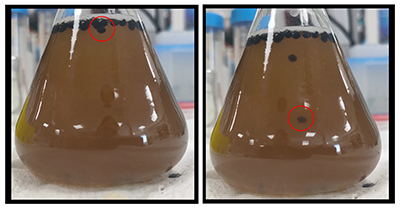FOR IMMEDIATE RELEASE
So, mushroom-zombies recently took over a fictional world, but in real life, they’re really not so scary. These fungi range in shape from broad, plate-like portobellos and gangly enokis to a version resembling a giant, shaggy lion’s mane. And now scientists are finding ways to grow mushrooms on new materials, as well as incorporate them in more sustainable products. Below are some recent papers published in ACS journals that report insights into additional applications for mushrooms. Reporters can request free access to these papers by emailing newsroom@acs.org.
“Uptake of Ultrashort Chain, Emerging, and Legacy Per- and Polyfluoroalkyl Substances (PFAS) in Edible Mushrooms (Agaricus spp.) Grown in a Polluted Substrate”
Journal of Agricultural & Food Chemistry
March 8, 2023
When food waste and manure are composted by microorganisms, they create gas that can be collected and burned to generate electricity. As a step toward a circular agricultural system, some people have suggested cultivating edible mushrooms on the final compost. However, the material could contain pollutants, such as per- and polyfluoroalkyl substances (PFAS). This team found that two types of mushrooms grown on PFAS-containing compost accumulated small to negligible amounts of PFAS, and they’d still be considered safe for humans to consume.
“Self-Healing Properties of Fibers Constructed from Mushroom-Derived Chitinous Polymers”
ACS Sustainable Chemistry & Engineering
Jan. 31, 2023
Here, researchers prepared textile fibers from dried white button mushrooms, Agaricus bisporus. They extracted chitin and glucan from the fungi and spun the resulting thick paste into long strands. In the presence of water, cut or damaged fibers repaired themselves in 30 seconds, returning to their original shape and strength, and woven fibers demonstrated larger-scale self-healing. This proof-of-concept study indicates that mushrooms are a potential feedstock for renewable fibers and sustainable textiles.
“Cellulose Fiber Rejects as Raw Material for Integrated Production of Pleurotus spp. Mushrooms and Activated Biochar for Removal of Emerging Pollutants from Aqueous Media”
ACS Omega
Jan. 31, 2023
In this paper, scientists showed that oyster and king trumpet mushrooms could thrive on the cellulose fibers leftover from recycling paper. Both varieties rapidly colonized the fibers and grew as well as, or slightly better than, mushrooms living on birch sawdust. And after the mushrooms were harvested, the team converted the spent cellulose fibers into activated biochars that adsorbed pharmaceuticals from water, extending the lifecycle of the waste.
“Mushroom-Mediated Reductive Bioconversion of Aldehyde-Rich Essential Oils for Aroma Alteration: A Rose-like Floral Bioflavor from Citronella Oil”
Journal of Agricultural & Food Chemistry
Jan. 13, 2023
Naturally derived food and beverage flavorings are in high demand by consumers. To generate a new one, this group added edible mushroom cultures to citronella essential oil. In less than 12 hours, the Neofomitella polyzonata cultures transformed the original oil into a product with floral, sweet, fresh and rosy notes. When panelists drank water flavored with the rose-like oil, they indicated that it would be acceptable to consumers. Therefore, mushrooms could be a sustainable route for converting essential oils into commercially valuable flavorings or fragrances, the researchers say.
###
The American Chemical Society (ACS) is a nonprofit organization chartered by the U.S. Congress. ACS’ mission is to advance the broader chemistry enterprise and its practitioners for the benefit of Earth and all its people. The Society is a global leader in promoting excellence in science education and providing access to chemistry-related information and research through its multiple research solutions, peer-reviewed journals, scientific conferences, eBooks and weekly news periodical Chemical & Engineering News. ACS journals are among the most cited, most trusted and most read within the scientific literature; however, ACS itself does not conduct chemical research. As a leader in scientific information solutions, its CAS division partners with global innovators to accelerate breakthroughs by curating, connecting and analyzing the world’s scientific knowledge. ACS’ main offices are in Washington, D.C., and Columbus, Ohio.
To automatically receive press releases from the American Chemical Society, contact newsroom@acs.org.
Note: ACS does not conduct research, but publishes and publicizes peer-reviewed scientific studies.







